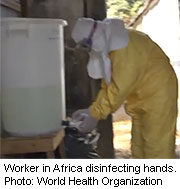
TUESDAY, Aug. 26, 2014 (HealthDay News) — Health care workers in poor nations often do not have enough protective gear to keep them safe from being infected with blood-borne viruses such as Ebola and HIV, a new study shows.
While the study was conducted before the current Ebola outbreak began in West Africa last spring, its findings are confirmed in statistics released Monday by the World Health Organization (WHO).
The international health agency reported that an “unprecedented” number of health care workers have lost their lives in the Ebola outbreak due in large part to a shortage of protective equipment; roughly 240 of the 2,615 infections reported since March have been doctors and nurses, and 120 of them have died, according to WHO.
“Ebola has taken the lives of prominent doctors in Sierra Leone and Liberia, depriving these countries not only of experienced and dedicated medical care, but also of inspiring national heroes,” the health agency said in its statement.
“In many cases, medical staff are at risk because no protective equipment is available — not even gloves and face masks,” the WHO statement added.
However, in the study reported online Aug. 26 in the journal Tropical Medicine and International Health, Johns Hopkins researchers found these shortages existed long before this latest Ebola outbreak.
In Liberia, only 56 percent of hospitals had protective eyewear for doctors and nurses and only 63 percent had sterile gloves. In Sierra Leone, those figures were 30 percent and 70 percent, respectively, the researchers found.
“Sadly, one of the only benefits of the Ebola crisis in West Africa may be to highlight the baseline lack of personal protective equipment such as eye protection, gloves and aprons for health care workers,” study leader Dr. Adam Kushner, an associate in the department of international health at Johns Hopkins Bloomberg School of Public Health in Baltimore, said in a Hopkins news release.
“These items are crucial to protect health care workers today, but were lacking long before the current crisis. We’ve seen this for many years with HIV,” he added.
The Hopkins researchers analyzed data from 399 hospitals in 13 low- and middle-income nations: Afghanistan, Bolivia, Gambia, Ghana, Liberia, Mongolia, Nigeria, Sierra Leone, Solomon Islands, Somalia, Sri Lanka, Tanzania and Zambia.
Overall, only 29 percent of the hospitals in the study always had eye protection for staff, 64 percent always had sterilizing equipment and 75 percent always had sterile gloves, according to the study.
Rates varied widely among countries. For example, all hospitals in Bolivia and Nigeria had sterile gloves, compared with one-quarter of hospitals in Afghanistan. None of the countries had 100 percent availability of all the protective items, which are standard in American hospitals.
Prevention of HIV infection was the focus of this study, but the Ebola virus is spread in the same way, through direct contact with bodily fluids of infected people or contact with items contaminated with such fluids, the researchers noted.
In the Ebola outbreak in West Africa, many health care workers have become infected, often due to a lack of proper infection-control procedures when working closely with patients.
“We can all learn from this new epidemic and be better prepared for the next one by remembering that inexpensive protective equipment can keep doctors and nurses safe from infection — and better able to care for patients who need them,” Kushner said. “It is imperative that we make this a priority.”
More information
The World Health Organization has more about Ebola.
Copyright © 2025 HealthDay. All rights reserved.

